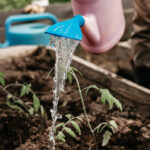Whether it’s spring, summer, or fall, we hear the same question, “When can I safely transplant the perennials in my yard?” Even though it would make sense to be able to transplant anytime the ground is not frozen, the transplanting process is a little different than the planting timeline. Since the transplanting process involves cutting established roots which are important for plant health, it’s important to only do so in early spring or in the fall as plants are starting to go into dormancy.
The transplanting process is very simple. Dig your plant out so that you are getting adequate roots with your plants. Typically, you should dig just past the drip line of your plant, but if you are noticing you are cutting through several big roots, then go back farther. Proceed to dig around the entire plant, while also loosening the roots underneath. Since you are transplanting either in the spring or fall, you will also want to cut back your plant at this time.
Post transplanting care is like planting containerized plants. Water the plant by laying a hose in the area set to a slow stream for 10-15 minutes every three to four days. As temperatures cool in the fall, you will be able to water those plants slightly less. When transplanting in the spring, your foliage will grow as normal but when transplanting in the fall, your foliage will most likely not grow back until spring.
While most plants can be transplanted either in the spring or fall, there are a couple that should only be transplanted in the fall. Peonies and Iris are both plants that require fall transplanting.



